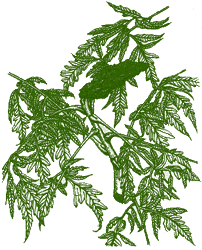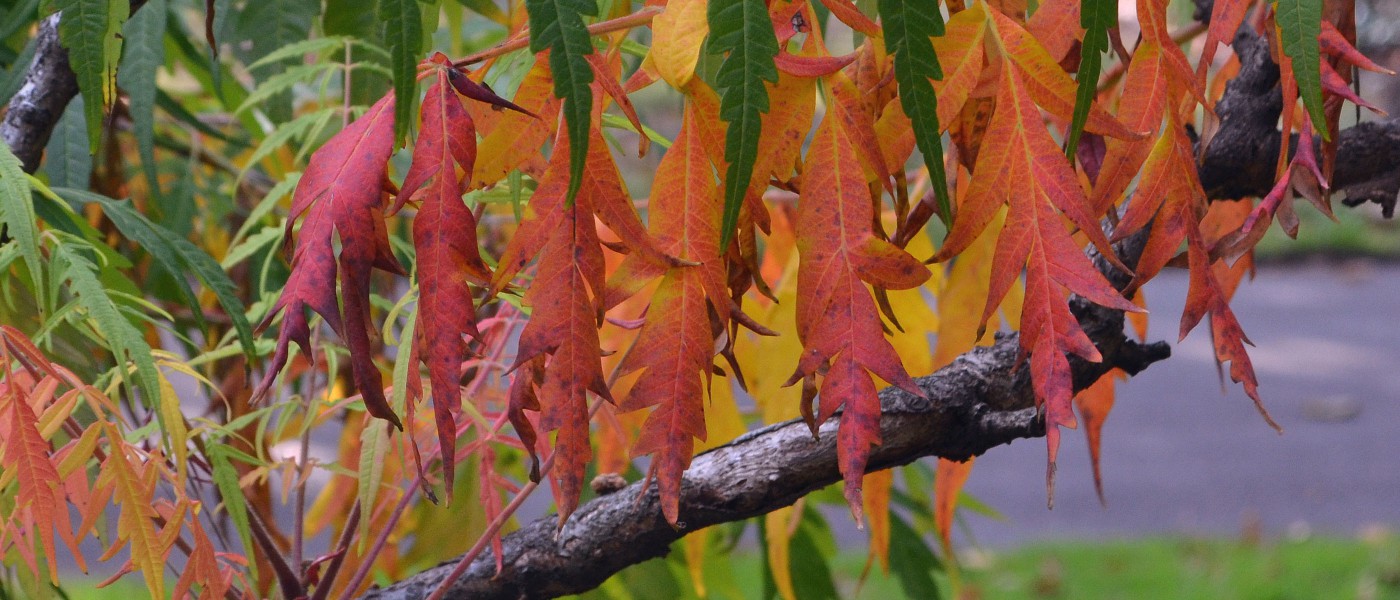Cutleaf Staghorn Sumac
Drought tolerant, pest resistant, and wildlife friendly, cutleaf staghorn sumac (Rhustyphina 'Laciniata') deserves to be more popular. This native plant can grow as either a large shrub or small tree, and it has long, fernlike leaves that turn a variety of gorgeous colors in autumn.
The real challenge of this plant is its size and growth habit. Rhus typhina can grow over 20 feet high but is more a gigantic shrub than a tree. It spreads laterally by vigorous suckering, forming dense multi-stemmed thickets. It is an impressive plant to build a garden around, but never try to garden under it.

The cultivar 'Laciniata' is an unusual cutleaf form of Rhus typhina, the staghorn sumac, which was selected from the wild population and propagated for garden use. 'Laciniata' resembles the wild form in all parts except its leaves which, like all leaves in this species, are pinnately compound—that is, leaflets are arranged in pairs along a central stalk. However, unlike ordinary Rhus typhina, 'Laciniata' leaflets are finely "cut," giving a textured, feathery look.
The common name staghorn sumac refers to the antler-like curve of the stems as well as the reddish-brown velvety fuzz covering the younger (upper) stems. This pubescence is reminiscent of the velvet-covered new horns of the stag or male deer. The pubescent stems of Rhus typhina distinguish it from Rhus glabra, the smooth sumac, which is a dead ringer to the untrained eye, except for the lack of fuzz.
Easy to Grow
The species Rhus typhina is widely distributed throughout the northeastern U.S. and southeastern Canada. It is found occasionally in wild places throughout the New York City area. Like other sumacs, it thrives in places where the soil is too thin or too dry for larger forest trees: natural openings in our native oak forests, wind-swept coastal shrublands and barren, rocky hilltops. It is also found in disturbed environments such as old fields, highway cuts, and along railroads.
As you might already have guessed about a plant that enjoys growing next to the railroad tracks, staghorn sumac is not fussy. Used as a garden plant, staghorn sumac and its cutleaf variety thrive in full sun or light shade with little or no watering, once established. Pest problems are rare. It grows in the poorest soil, as long as its roots are not waterlogged, and appears to be tolerant of the reflected heat, dust, and smoke of city gardens.
The cutleaf staghorn sumac, like the wild form, is variable in size, but has the potential to grow over 20 feet with an even greater spread. It gradually forms a large dense grove—an excellent shelter for wildlife. However, its size and spread can be controlled. One method involves pruning; cut some or all of the stems to ground level in early spring before growth begins. Regrowth is vigorous. Encircling plants with metal root barriers is an effective alternative to regular pruning. The enclosure not only fences in the sucker shoots but causes a "pot-bound" condition that dwarfs the entire plant—until it eventually goes into a noticeable decline or breaks free of the barrier, at which time it becomes necessary to tear the shrub out, repropagate from suckers and begin again.
Propagation
Seedlings of 'Laciniata' do not have the cut-leafed trait, and so it is necessary to propagate the cut-leaf form vegetatively. Grow new plants from root cuttings, or by digging up some of the abundantly produced "suckers" (new shoots emerging at ground level) complete with roots.
Seasonal Traits
The overall appearance and "feel" of this plant changes radically with the seasons. It is unusually fine-textured, even fernlike in leaf, but unusually coarse in winter, when the naked stems with their stout fuzzy twigs, topped with dried-out fruit clusters, look something like an assembly of giant hat racks in the landscape. Most people prefer this plant with its clothes on.
The two-foot-long compound leaves are held up at an angle not quite horizontal but slightly upswept. This creates a pattern of slanted green lines, repeated at intervals because of the multistemmed habit, giving the plant a distinctive profile in leaf—a bit like a big rambling house with a complex gabled roof.
Flower clusters appear in June. By midsummer they resemble 6-inch-long lopsided cones of tightly bunched velvety red buttons. Each cone-shaped inflorescence is positioned at a branch tip and is the culmination of the season's growth. Observed from a great enough distance, the flower clusters look like those of the plume-type cockscomb.
By late summer the flower clusters ripen into bunches of fuzzy, cranberrylike fruits. Most will remain on the sumac well into winter. Although edible, they are very sour and apparently not the first choice of birds and foraging animals. Later in winter as the pickings get slimmer and the berries lose their tartness, they are eaten. Some wild-food connoisseurs and adventurous gardeners steep the fruits in hot water, making a sour lemonadelike concoction.
By far the glory of sumacs is fall color, and the cutleaf staghorn sumac is one of the best of the bunch. Its autumn show starts earlier and lasts longer than most other kinds of trees; the leaves blaze intensely in fiery shades of orange, red, and gold.
How to Use It
Cutleaf staghorn sumac has ornamental possibilities that go beyond heavy-duty applications like highway landscaping. For large suburban properties it makes a good buffer plant for peripheral areas, where it provides not only summer privacy but food and habitat for animals as well; it makes an excellent "transitional plant" between tamed and wild areas.
With its size controlled by pruning and/or root confinement, cutleaf staghorn sumac can be used in manicured gardens. It can serve as a bolder, textured alternative to the ubiquitous dogwood and Japanese maple when planted off the corner of a structure to anchor a foundation planting. For hot outdoor plazas, it is a rugged survivor and makes a strong "statement."
For a mixed perennial border with a bold texture, try it as a specimen shrub to be cut back to the ground annually. Its wild appearance mixes especially well with grasses, and its spectacular fall color adds beautifully to any display of asters, chrysanthemums or goldenrod.
Where to See It
Brooklyn Botanic Garden has two specimens of cutleaf staghorn sumac. Because the two sumacs grow in very different areas, they received very different treatment at planting time and look very different today.
Our first specimen—on the Flatbush Avenue border mound, a wild, low-use, low-maintenance area—has been given little or no irrigation or fertilizer but allowed to run free. After 25 years it has formed an impressive erosion-stopping thicket, about 15 feet high and 25 feet across.
Our second specimen—in the Cashew Family section of the Plant Family Collection on a sloping manicured lawn below the Tropical Pavilion—has grown for 9 years within the confines of a foot-deep aluminum root barrier. Despite annual fertilization and weekly watering, it has grown only as wide as the barrier has permitted and at 8 feet is barely taller than it was at planting time.


